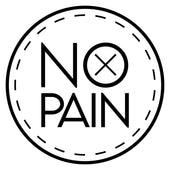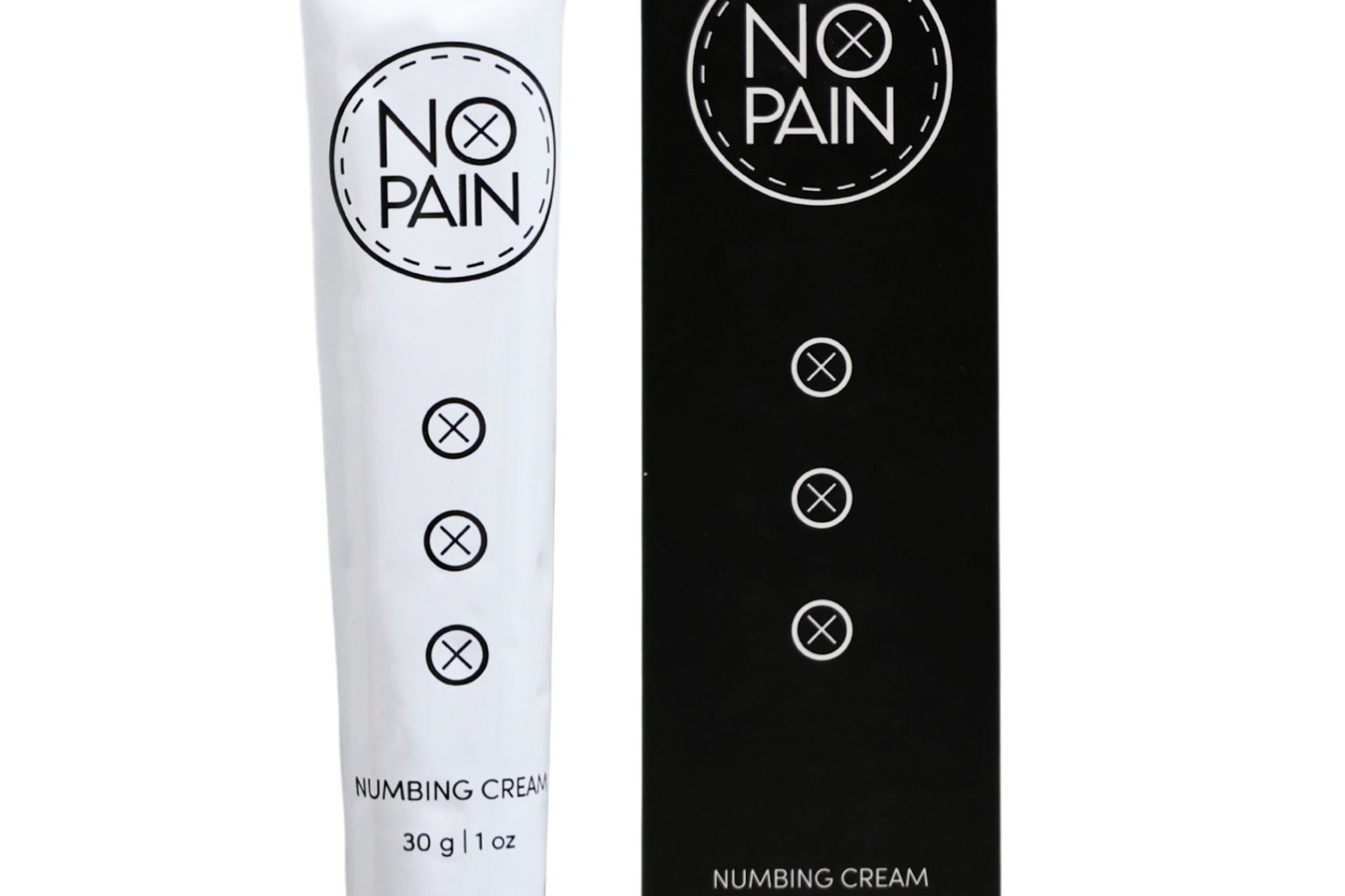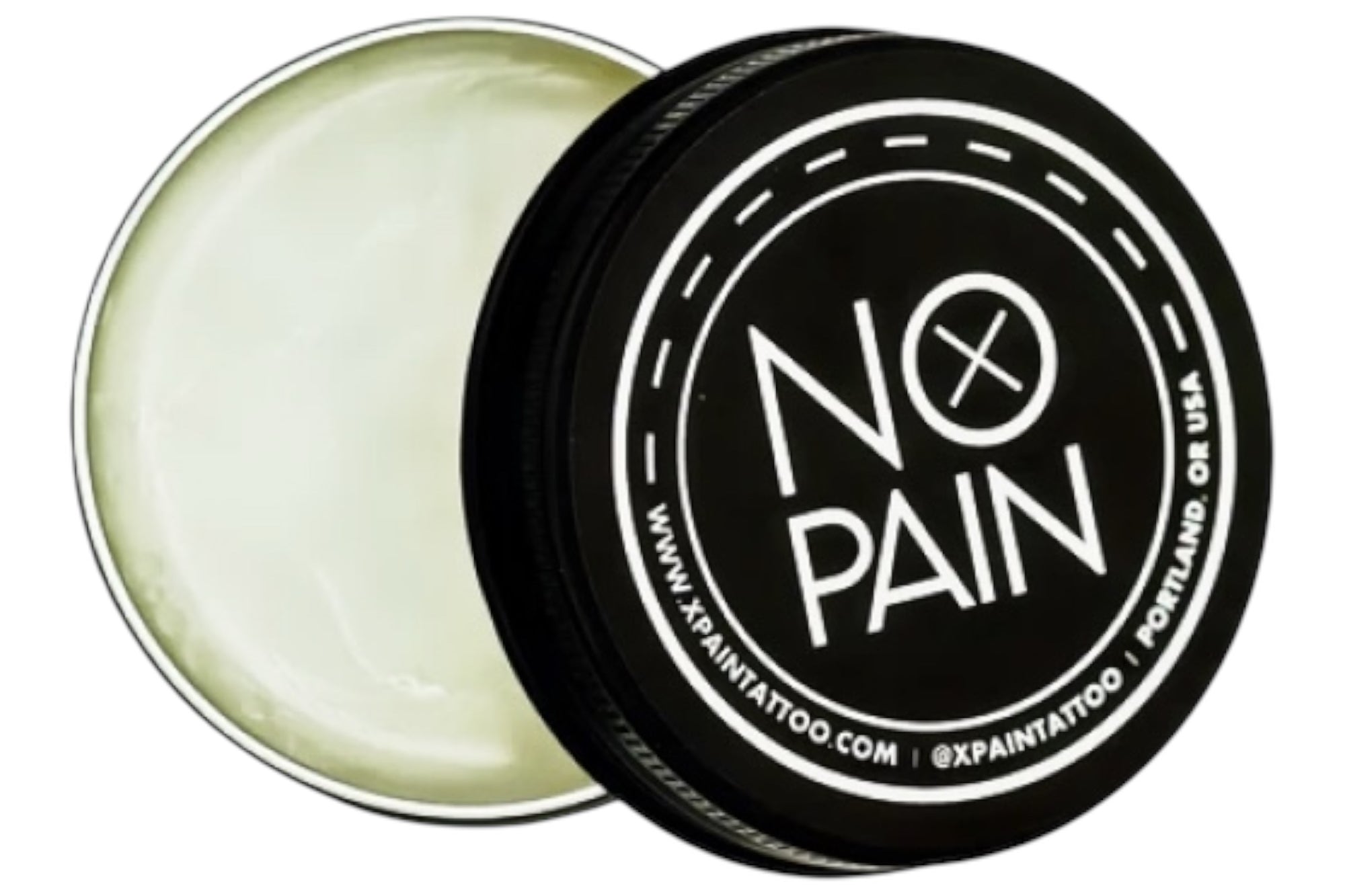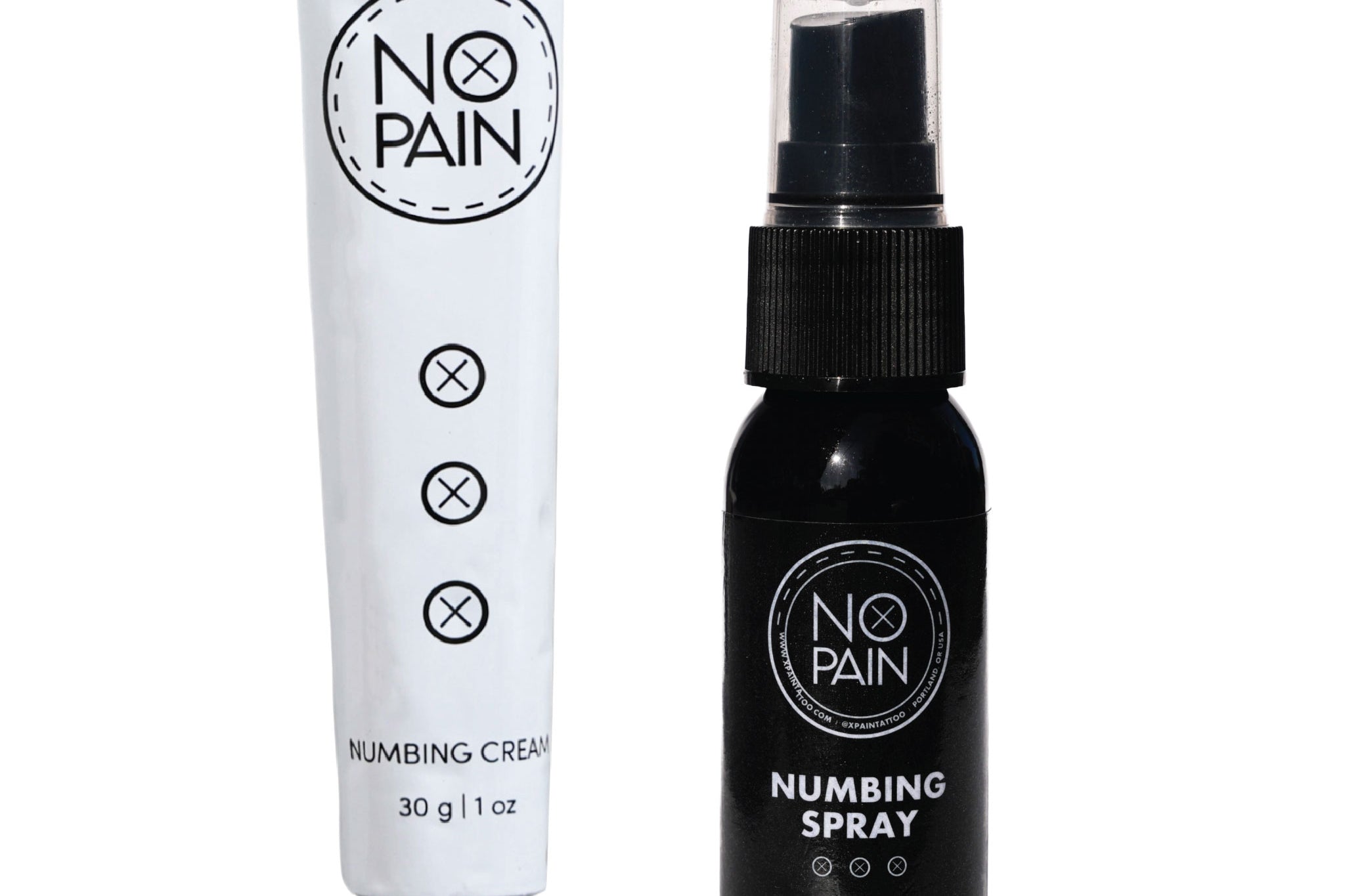How To Use No Pain Products: Your Guide to the Ultimate Tattoo Experience
Welcome to your essential guide for maximizing comfort and care throughout your tattoo journey! At No Pain, we've perfected a lineup of tattoo essentials designed to make every step—from prep to long-term healing—seamless, comfortable, and vibrant. Follow these simple steps to unlock the full potential of your No Pain products and truly elevate your ink adventure.
Numbing Cream
Click Here For Full Video Instructions
The Day Before: Setting the Stage for Comfort
Preparation is everything when it comes to a smooth (and pain-free) tattoo session. Here’s how to get your skin and body ready the day before you sit in the chair:
- Spot Test the Cream: Apply a small amount of No Pain Tattoo Numbing Cream on a discreet patch of skin (inner bicep or thigh area works great). This helps check for any skin sensitivity. A bit of mild redness can happen, but steer clear if you notice an unusual reaction.
- What to Avoid Before Application: For best results, avoid alcohol, beer, and even milk in the 24 hours leading up to your appointment. Alcohol can thin your blood and counteract the effectiveness of topical numbing creams, while milk may upset sensitive skin for some people.
No Pain Tattoo Numbing Cream: Your Pre-Session Prep Master
(For an unbelievably comfortable start to your tattoo session.)
- When to Use: 1-2 hours before your tattoo appointment begins.
- How to Use:
- Cleanse and thoroughly dry the skin area where your tattoo will be.
- (Optional) Sanitize with alcohol.
- Apply a thick, visible layer (2-3mm) of numbing cream to the skin. Do not rub it in completely.
- Cover the applied area firmly (but not constricting) with plastic wrap to activate the numbing effect. Make sure the entire tattoo area is sealed—this helps the cream stay moist, prevents it from drying out, and keeps out any debris until your artist is ready to begin.
- Leave on for 60-90 minutes for lighter sessions, or 90-120 minutes for intense/longer sessions.
- Wipe off with a paper towel and begin session.
Numbing Spray
How to Use No Pain Tattoo Numbing Spray
Our No Pain Tattoo Numbing Spray is a powerful mid-session anesthetic designed to be used after the tattoo outline is complete. It is the perfect tool for managing pain during long sessions, especially on tender areas.
Unlike a pre-session numbing cream that works on unbroken skin, our spray is formulated with Lidocaine and a vasoconstrictor to provide rapid relief and reduce swelling on broken skin.
(For a complete breakdown of the science, check out our blog: Tattoo Numbing Spray: A Guide to Mid-Session Pain Relief.)
How to Use for Optimal Mid-Session Relief
For best results and targeted pain management when your skin is already broken (outline at minimum):
- Prep: Ask your artist to wipe down the broken skin where the numbing is needed.
- Apply Generously: Spray a layer of the Numbing Spray directly onto the working area.
- Cover & Activate: Cover the sprayed area completely with plastic wrap (cling film) for about 5-10 minutes to allow the powerful agents to penetrate.
- Wipe & Continue: Gently wipe off any excess gel before your artist resumes tattooing. You are now prepped to power through!
- Reapply: Spray the area as needed. No need to rewrap and wait.
Final Mile Gel
No Pain Tattoo Final Mile Gel: The Mid-Session Game Changer
(Conquer the final push and achieve flawless detail without the discomfort.)
- When to Use: During your tattoo session, after the outline is complete and the skin is broken. Perfect for the finishing touches or bridging long sessions.
- How to Use:
- Clean and wipe the broken-skin area.
- Apply a thin, even layer of Final Mile Gel over the tattooed section.
- Cover the applied area with plastic wrap for 10-20 minutes to allow activation.
- Wipe off any excess gel before your artist continues tattooing.
- Pro Tip: This gel tackles that dreaded "final push" discomfort, quickly reducing swelling and providing 20-30 minutes of targeted numbing relief. And Final Mile Gel can be reapplied! It empowers you to get through your session, or your artist to a good stopping point.
Cleansing Foam
No Pain Tattoo Cleansing Foam: Your Daily Cleanse Guardian
(Maintain pristine hygiene for optimal tattoo healing.)
- When to Use: From the very first wash after your tattoo session, and daily throughout the entire healing process.
- How to Use:
- WASH YOUR HANDS! Then...
- Wet your fresh tattoo with lukewarm water.
- Pump a small amount of Cleansing Foam directly onto your fingertips.
- Lather the foam over your tattoo in soft, circular motions. Do not scrub or scratch.
- Rinse thoroughly with lukewarm water until all foam is gone.
- Dry by patting with a clean paper towel.
- Pro Tip: This gentle, antibacterial foam removes impurities without irritation, ensuring your tattoo stays clean and hygienic for optimal healing. A vital, hassle-free step for healthy, vibrant ink!
Soothing Gel
No Pain Tattoo Soothing Gel: Instant Cool Relief
(Calm and comfort your fresh tattoo with immediate relief.)
- When to Use: When you get home, take the bandage off and wash your new tattoo, and during the initial days of healing (typically the first 2-3 days) to calm irritation.
- How to Use:
- Cleanse the fresh tattoo with No Pain Cleansing Foam.
- Pat dry with a clean paper towel.Apply a thin, even layer of Soothing Gel over the tattooed area.
- Allow to air dry naturally.
- Reapply as needed throughout the day for comforting relief from redness, swelling, and itchiness.
- Pro Tip: Helps maintain elasticity in tough areas like elbows, elbow ditch, knees, knee ditch, waist, and feet. Experience instant cooling relief and keep irritation at bay. This gel is your go-to for immediate post-session comfort.
Aftercare Balm
No Pain Tattoo Aftercare Balm: The Healing Protector
(Nourish your healing tattoo for vibrant, long-lasting results.)
- When to Use: Once your tattoo has passed the initial weeping stage (typically a few days in, when the skin has closed) and after cleansing.
- How to Use:
- Wash your healing tattoo with No Pain Cleansing Foam.
- Dry the area completely by patting with a clean paper towel.
- Apply a very thin, breathable layer of Aftercare Balm. A little goes a long way – don't over-apply!
- Repeat 2-3 times daily, or as advised by your artist.
- Pro Tip: This nourishing balm keeps your healing tattoo moisturized, minimizes scabbing, and locks in vibrancy, ensuring your beautiful art heals perfectly and looks its best for years to come.
FAQ
Can You Apply Numbing Cream After Your Tattoo Has Started?
Wondering if you can apply numbing cream during a tattoo session? Here’s what you need to know:
If you begin your tattoo without pre-applying the numbing cream, adding it partway through won’t be as effective. The numbing properties are best activated when applied to intact skin before the session begins. Once the tattooing has started and skin is already broken, most lidocaine-based creams simply don’t deliver their full numbing punch if applied late. You will achieve a better result if you use a product like our Numbing Spray or Final Mile Gel.
However, if you’ve already applied cream before your session, you can have your artist gently reapply it during breaks. Thanks to the open skin, it may work a bit faster—usually needing just 20 minutes or so to set in. For maximum comfort, plan ahead and stick to that generous pre-session application. That way, you and your artist both get the smooth, discomfort-free experience you’re aiming for.
Do I need both the Cream and the Spray?
For any tattoo session scheduled for 3 hours or more, we highly recommend using both products. Start with the Numbing Cream for a pain-free start, and bring the Numbing Spray for your artist to apply if you start to feel discomfort. This combination, found in our Comfort Bundle, is the best way to ensure you can finish your session without having to tap out.
What’s the Magic Behind the Numb?
The secret sauce in most numbing creams is lidocaine. This powerhouse ingredient is a local anesthetic, which means it temporarily blocks those pesky pain signals before they even hit your brain. Lidocaine is often the go-to choice for professionals—it’s trusted in medical settings for minor procedures and, best of all, it lets you breeze through even the trickiest spots (looking at you, ribcage) without a wince. The result? Smooth sailing from first line to final swipe.
Can Numbing Cream be Reapplied?
Reapplying Numbing Cream: Activation Time on Broken Skin:
Wondering how fast numbing cream kicks in once your tattoo session is underway? Good news: When the skin is already broken, numbing creams—like No Pain Tattoo Numbing Cream—typically get to work much quicker. After reapplication, you’ll only need to wait about 20–40 minutes before you start feeling renewed relief. This faster action means less downtime and more comfort as you power through your session.
Quick tip: Always ask your artist to wipe and dry the area before reapplying, and cover with plastic wrap to maximize effectiveness.
Can I Use Numbing Cream if I Have Sensitive Skin?
Sensitive Skin or Allergies? Patch Test First!
(Your comfort and safety always come first.)
Before using numbing cream: If you have sensitive skin or any known allergies, it's essential to play it safe. Here's what to do:
- Patch Test: At least one day prior to your appointment, apply a small amount of numbing cream to a discreet area of skin you plan to have tattooed.
- Observe: Watch for any unusual reactions, such as excessive redness, swelling, or irritation. Mild redness can be normal, but if you notice discomfort or a rash, discontinue use immediately.
- Consult if Needed: If you have a history of skin issues or experience any adverse effects during your patch test, reach out to your doctor or dermatologist before moving ahead.
- Check Ingredients: Always read the ingredient list carefully—especially if you have sensitivities to common anesthetics or preservatives.
Taking these easy precautions gives you peace of mind for a more comfortable, worry-free tattoo experience!
Why Should You Spot Test First?
Before you commit to slathering on the numbing cream, it’s smart to do a quick spot test on the intended tattoo area about 24 hours ahead of your appointment. This practice isn’t just for the cautious—it's essential for making sure your skin will happily play along with the product you’ve chosen (think: No Pain Tattoo, Ebanel, Dr. Numb, or TattooNumbx). A small dab will reveal if your skin has any unexpected sensitivities—even the best formulas can stir up mild redness for some, which is usually harmless but worth knowing ahead of time.
The goal here? Peace of mind. By testing the day before, you’ll avoid any surprises mid-session and ensure your comfort plan stays on track.
Can I use your aftercare products on a tattoo that has been numbed?
Yes. Our numbing products are water-based and will not affect the healing process. Once your tattoo is finished, you should immediately begin your artist's recommended aftercare procedure. Our No Pain Tattoo Aftercare Bundle is designed to work perfectly, starting with that first crucial wash. (Related: A Guide to Tattoo Aftercare)
Should You Let Your Tattoo Artist Know You’re Using Numbing Cream?
Absolutely—open communication is key to a stellar tattoo experience! Letting your artist know ahead of time that you plan to use numbing cream helps them understand what to expect, keeps the session running smoothly, and makes sure everyone’s on the same page.
Still deciding? Chat with your artist during the consultation. Most artists are comfortable working with tattoo numbing creams like No Pain Tattoo Numbing Cream, but preferences can vary. By mentioning it early, you’ll avoid surprises—and ensure your comfort and theirs from the very first line. A little heads-up goes a long way.
What's the difference between the Soothing Gel and the Aftercare Balm?
They are designed for different stages of healing.
- The No Pain Tattoo Soothing Gel is for the initial phase (first few days). It is a lightweight, water-based gel that provides cooling relief, calms inflammation, and soothes the "angry" feeling of a fresh tattoo without clogging pores.
- The No Pain Tattoo Aftercare Balm is for the peeling and long-term phase. It is a richer, nutrient-dense balm that provides deep, lasting moisture to prevent heavy scabbing, relieve itching, and keep your tattoo vibrant for life.



